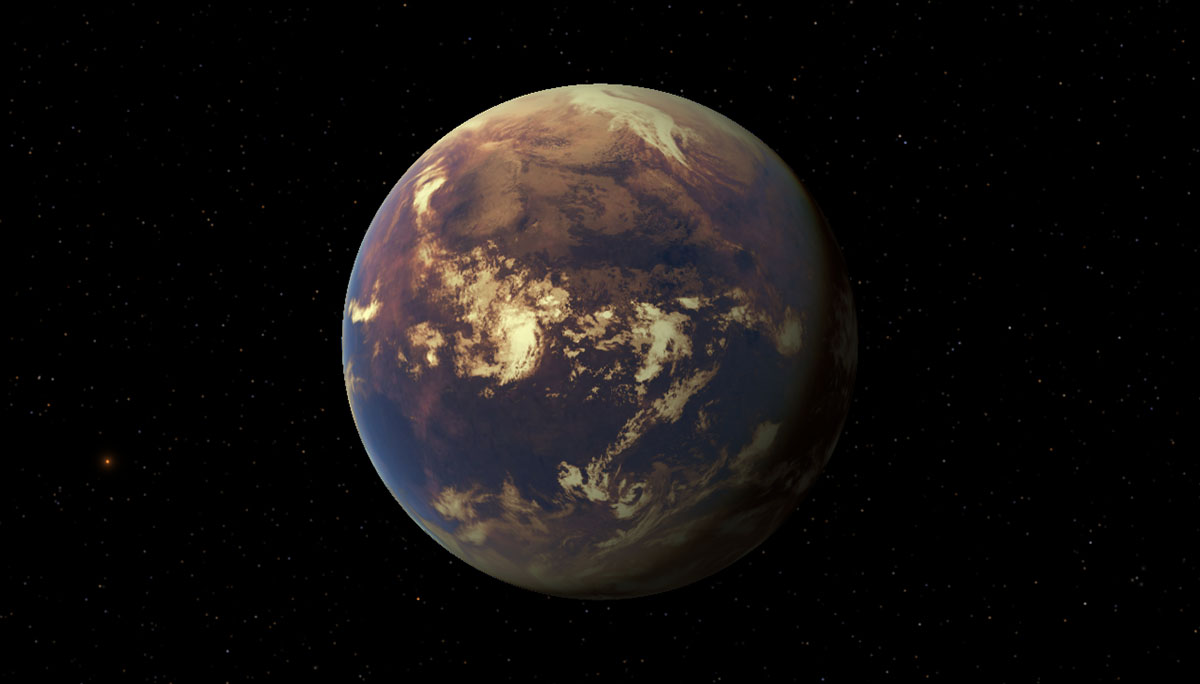gliese 581d gets the nod for habitability

At the rate we’re going, it seems that the first target for one of our future interstellar spacecraft will just have to be the Gliese 581 system. Beyond the initial hype generated by the announcement of planet 581g and a very deflating set of calculations showing that it may have just been a mirage, there were still planets with a little potential for life as we can understand it. This is why when discussing the practicality of colonizing the solar system in question, I brought up two worlds which seem to have faded from our collective memories. Now, it seems that one of these worlds, 581d, may actually be the terrestrial, habitable planet for which astronomers have been searching. Originally thought too cold for liquid water, the planet was put on the back shelf until an advanced climate model ran by French scientists showed that such a world could actually have oceans, rain, and stay warm enough to avoid having its night side frozen solid if it were tidally locked in its orbit. How? Well, as it turns out, it all comes down to sunlight, or rather to the right wavelength of sunlight. For a big planet with an atmosphere rich in carbon dioxide, a red star may actually be an enabler of a dynamic, warm climate.
When astronomers first considered Gliese 581d as a candidate for habitability, they thought that much of the light from its parent star would be reflected back into space as happens on our world. However, the light we get from the Sun has a shorter wavelength and gets scattered when it meets air molecules and other small, fine particles in our atmosphere. This phenomenon called Rayleigh scattering and it’s what gives our skies a bluish tint. When dealing with longer wavelengths, like you’d find coming from oh say a red dwarf star, the red light scatters less and more of it reaches deeper into the kind of thick carbon dioxide atmospheres that seem common for large, rocky planets. As a result, the skies of Gliese 581d would have a murky reddish glow and the conditions would support a water cycle, which we know to be a key for enabling life. If this model is right, it would not only mean that a planet just over 20 light years away is habitable, but that it’s probably inhabited by something since it’s difficult to imagine a watery world without life. After all, once upon a time Earth’s air had a lot of carbon dioxide and other gases we consider noxious and deadly today while its oceans were home to a countless variety of bacterial colonies thriving for billions of years, reproducing and growing away while much of the planet was erupting away with vast lava flows and toxic plumes that made the surface unlivable.
Whether 581d is tidally locked or not could determine what could live there and where we could find traces of those living things. Having a perpetual day side could allow for constant photosynthesis for organisms which would form the base of food chains in which the lit hemisphere is the central hub of all activity. Life could exist on the night side as well, but if photosynthesis didn’t evolve on 581d, the base of the food chains would be an assortment of bacteria feeding off thermal vents on ocean floors. Were the planet to rotate around its axis and have an actual night and day cycle, we could expect living things to be more widespread as more habitats will be available to them. Either way, the entire planet would be warmed thanks to wind circulation, but with direct sunlight across 581d a greater variety of organisms may have chances to establish new footholds to escape predation or to take full advantage of abundant resources. This is after all how we think all our forests started out, as primitive plants which grew with no competition, feeding on sunlight and carbon dioxide. If 581d were to repeat this evolutionary step, we could find traces of some sort of biological activity in its atmosphere. This is all conjecture, of course, and further observations will need to be made to figure out more about this world, but since we now know its potential, we should devote some time and resources to study it.
Again, it should be noted that as far as interstellar objects go, Gliese 581 is very close by, close enough to be of interest to some sort of mission at some point in the future. Should our hunches turn out to be right, there’s a very strong case to be made for at least trying to send a probe there. It may take a very long time to come up with the required technology to make the trip quickly enough, but with a very reasonable target in sight, it may just motivate enough space agencies, scientists, and engineers to rise to the challenge and create the brand new generations of computers, engines, reactors, and materials required for the journey. Maybe discovering and confirming that 581d can support life is exactly what we need to motivate future space explorers. Though we also need to be very cautious not to get too attached to the idea that 581d must be habitable because the models may be wrong and we don’t want to let confirmation bias take over the astronomers’ observations. It’s fun to speculate and the models seem very promising thus far, but at the end of the day, real data will need to have the last word on whether Gliese 581d is really habitable or not.
Wordsworth, R., et al. (2011). Gliese 581d is the first discovered terrestrial-mass exoplanet in the habitable zone The Astrophysical Journal, 733 (2) DOI: 10.1088/2041–8205/733/2/L48





